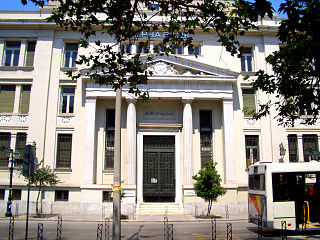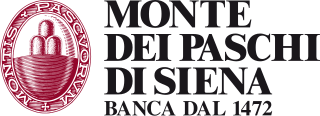Related Research Articles

Alpha Bank is the fourth largest Greek bank by total assets. It has a subsidiary and branch in London, England and subsidiaries in Cyprus and Romania. Founded in 1879, it has been controlled by the Costopoulos family since its inception. Most recently, Ioannis Costopoulos, grandson of original founder John F. Costopoulos, and nephew of Stavros Costopoulos, foreign minister in the government of Georgios Papandreou, served in many important capacities before his death March 9, 2021."en".

Banca Monte dei Paschi di Siena S.p.A., known as BMPS or just MPS, is an Italian bank. Tracing its history to a mount of piety founded in 1472 and established in its present form in 1624, it is the world's oldest or second oldest bank, depending on the definition, and the fifth largest Italian commercial and retail bank.

Dexia N.V./S.A., or the Dexia Group, is a Franco-Belgian financial institution formed in 1996. At its peak in 2010, it had about 35,200 members of staff and a core shareholders' equity of €19.2 billion.

UniCredit S.p.A. is an international banking group headquartered in Milan. It is Italy's only systemically important bank and the world's 34th largest by assets. It was formed through the merger of Credito Italiano and Unicredito in 1998 but has a corporate identity stretching back to its first foundation in 1870 as Banca di Genova. UniCredit is listed on the Milan and Frankfurt stock exchanges and is a constituent stock of the Euro Stoxx 50 index of leading shares.
Valuation risk is the risk that an entity suffers a loss when trading an asset or a liability due to a difference between the accounting value and the price effectively obtained in the trade.
The Supervisory Capital Assessment Program, publicly described as the bank stress tests, was an assessment of capital conducted by the Federal Reserve System and thrift supervisors to determine if the largest U.S. financial organizations had sufficient capital buffers to withstand the recession and the financial market turmoil. The test used two macroeconomic scenarios, one based on baseline conditions and the other with more pessimistic expectations, to plot a 'What If?' exploration into the banking situation in the rest of 2009 and into 2010. The capital levels at 19 institutions were assessed based on their Tier 1 common capital, although it was originally thought that regulators would use tangible common equity as the yardstick. The results of the tests were released on May 7, 2009, at 5pm EST.
In finance, a stress test is an analysis or simulation designed to determine the ability of a given financial instrument or financial institution to deal with an economic crisis. Instead of doing financial projection on a "best estimate" basis, a company or its regulators may do stress testing where they look at how robust a financial instrument is in certain crashes, a form of scenario analysis. They may test the instrument under, for example, the following stresses:
Macroprudential regulation is the approach to financial regulation that aims to mitigate risk to the financial system as a whole. In the aftermath of the late-2000s financial crisis, there is a growing consensus among policymakers and economic researchers about the need to re-orient the regulatory framework towards a macroprudential perspective.
Basel III is the third Basel Accord, a framework that sets international standards for bank capital adequacy, stress testing, and liquidity requirements. Augmenting and superseding parts of the Basel II standards, it was developed in response to the deficiencies in financial regulation revealed by the financial crisis of 2007–08. It is intended to strengthen bank capital requirements by increasing minimum capital requirements, holdings of high quality liquid assets, and decreasing bank leverage.
The European System of Financial Supervision (ESFS) is the framework for financial supervision in the European Union that has been in operation since 2011. The system consists of the European Supervisory Authorities (ESAs), the European Systemic Risk Board, the Joint Committee of the European Supervisory Authorities, and the national supervisory authorities of EU member states. It was proposed by the European Commission in 2009 in response to the financial crisis of 2007–08.

The European Banking Authority (EBA) is a regulatory agency of the European Union headquartered in La Défense, Île-de-France. Its activities include conducting stress tests on European banks to increase transparency in the European financial system and identifying weaknesses in banks' capital structures.
Veneto Banca S.p.A. is a former Italian bank headquartered in Montebelluna, Italy and currently a wind-down unit.
A European Union-wide banking stress test exercise has been conducted by the Committee of European Banking Supervisors every year since 2009. The second instance was performed in July 2010. The Council of the European Union mandated that Committee so to do, in the aftermath of the global financial crisis which started in 2007.

European Banking Supervision, also known as the Single Supervisory Mechanism (SSM), is the policy framework for the prudential supervision of banks in the euro area. It is centered on the European Central Bank (ECB), whose supervisory arm is referred to as ECB Banking Supervision. EU member states outside of the euro area can also participate on a voluntary basis, as was the case of Bulgaria as of late 2023. European Banking Supervision was established by Regulation 1024/2013 of the Council, also known as the SSM Regulation, which also created its central decision-making body, the ECB Supervisory Board.
The banking union of the European Union is the transfer of responsibility for banking policy from the national to the EU level in several EU member states, initiated in 2012 as a response to the Eurozone crisis. The motivation for banking union was the fragility of numerous banks in the Eurozone, and the identification of vicious circle between credit conditions for these banks and the sovereign credit of their respective home countries. In several countries, private debts arising from a property bubble were transferred to sovereign debt as a result of banking system bailouts and government responses to slowing economies post-bubble. Conversely, weakness in sovereign credit resulted in deterioration of the balance sheet position of the banking sector, not least because of high domestic sovereign exposures of the banks.

Banca Popolare di Vicenza (BPVi) was an Italian bank and currently a winding-down company. The banking group along was the 15th-largest retail and corporate bank of Italy by total assets at 31 December 2016, according to Mediobanca. However, its sister bank Veneto Banca also ranked 16th in the same ranking, making the whole banking group that under Atlante, had a higher pro-forma total assets than 10th of the same ranking, Crédit Agricole Italia. Due to its size, BPVi and Veneto Banca were both supervised by the European Central Bank directly, instead of the Bank of Italy.
Comprehensive Capital Analysis and Review (CCAR) is a United States regulatory framework introduced by the Federal Reserve in 2009 to assess, regulate, and supervise large banks and financial institutions – collectively referred to in the framework as bank holding companies (BHCs). It was an extension of the stress tests performed during the Financial crisis of 2007–2008.
The European Union-wide banking stress test 2016 was conducted by the European Banking Authority (EBA) in order to assess the resilience of financial institutions in the European Union to a hypothetical adverse market scenario. The stress test was formally launched on 24 February 2016 with a publication of the final methodology and templates as well as the scenarios. It covered over 70% of the national banking-industry assets in the euro area, each EU member state and Norway. 53 EU banks participated in the exercise, 39 of which are directly supervised by the ECB under European Banking Supervision. The outcomes of the exercise, including banks' individual results, were published on 29 July 2016, at 22:00 CET.
References
- ↑ "Results of 2014 EU‐wide stress test" (PDF). European Banking Authority. 26 October 2014.
- ↑ "EBA publishes common methodology and scenario for 2014 EU-banks stress test". European Banking Authority. 29 April 2014.